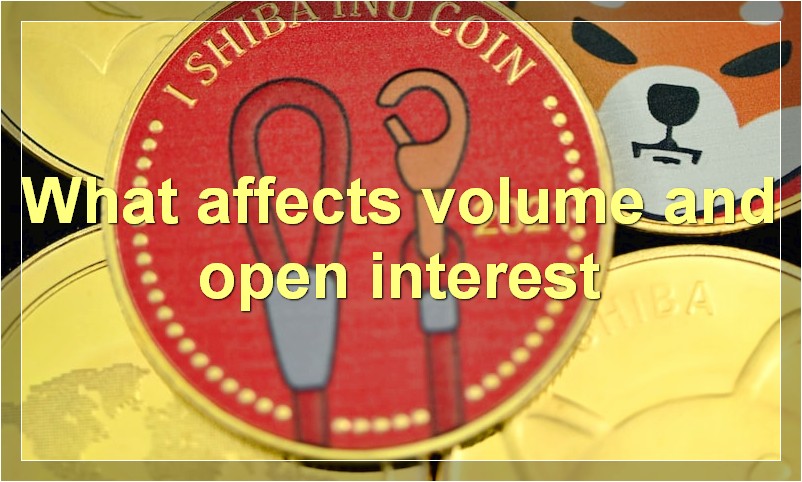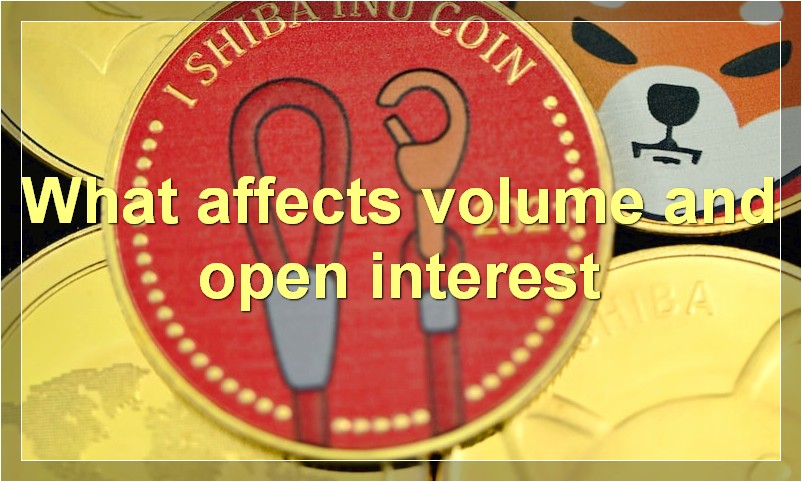Open interest is the number of outstanding contracts, including both short and long positions, that are held by traders in a given market. Volume, on the other hand, is simply the number of contracts traded in a day. So what’s the relationship between the two?
What is the difference between volume and open interest
In the world of investing, there are a lot of terms that get thrown around. Volume and open interest are two terms that are often used interchangeably, but they actually have very different meanings. Here’s a look at the difference between volume and open interest.
Volume is the number of shares or contracts traded in a given period of time. For stocks, volume is typically measured in terms of the number of shares traded. For futures contracts, volume is measured in terms of the number of contracts traded.
Open interest, on the other hand, is the number of outstanding contracts that are held by traders at the end of the day. Open interest represents the number of contracts that have been traded but not yet closed out. For example, if there are 100 contracts open for a particular stock, that means that 100 traders are currently holding positions in that stock.
The difference between volume and open interest is important to understand because they can give you different insights into the market. Volume is a measure of activity, while open interest is a measure of liquidity.
For example, let’s say that there’s a stock with high volume but low open interest. This could mean that there’s a lot of trading activity going on, but most of the trades are being made by a small group of traders. In contrast, a stock with low volume but high open interest could mean that there’s less trading activity, but there are more traders involved.
Both volume and open interest can be useful indicators when you’re trying to assess the health of a market. If you see high volume and high open interest, it could be a sign of a robust market with plenty of liquidity. If you see low volume and low open interest, it could be a sign of a weak market with little activity or liquidity.
What affects volume and open interest

Volume is the number of contracts traded during a specified time period. Open interest is the number of outstanding contracts at the end of a trading day. These two measures are used by traders to gauge the strength of a market.
Volume is affected by the number of traders in the market, the number of contracts traded, and the level of activity. Open interest is affected by the number of new contracts created, the number of old contracts that expire, and the level of activity.
How do changes in volume and open interest affect trading
In order to trade successfully, it is important to understand how changes in volume and open interest can affect trading. An increase in volume usually indicates increased interest in a security, while an increase in open interest usually indicates new positions are being taken.
A decrease in volume can sometimes be interpreted as a lack of interest in a security, while a decrease in open interest can indicate that positions are being closed. However, it is important to note that these are not always the case, and other factors should be considered before making any decisions.
Changes in volume and open interest can also be affected by a number of other factors, such as the time of day, the day of the week, or holidays. It is important to take all of these factors into account when making trading decisions.
What is the relationship between volume and open interest
Open interest is the number of outstanding contracts that are held by traders at the end of the day. Volume is the number of contracts that are traded during the day. The relationship between volume and open interest is that when volume is high, open interest usually increases as well. This happens because when more contracts are traded, there are more contracts that need to be settled at the end of the day.
Why is volume important when considering open interest
Open interest is the number of contracts that are outstanding in a derivatives market. It is a measure of market activity, and is used by traders to gauge the liquidity of a market and the level of participation.
The volume of a market is the number of contracts that are traded in a period of time. It is a measure of market activity, and is used by traders to gauge the level of participation.
Open interest and volume are both important measures of market activity. Open interest represents the number of contracts that are outstanding, while volume represents the number of contracts that are traded in a period of time. Both measures are used by traders to gauge the liquidity of a market and the level of participation.
How can you use volume and open interest to predict future price movements

When it comes to trading futures, there are a few key indicators that can help you predict future price movements. Two of the most important indicators are volume and open interest. Here’s a look at how you can use these two indicators to your advantage.
Volume is the number of contracts that are traded in a given period of time. Open interest is the number of contracts that are held by traders at the end of a trading day. These two indicators can give you a good idea of where prices are headed in the future.
If volume is increasing, it means that more traders are getting involved in the market and that prices are likely to go up. On the other hand, if volume is decreasing, it means that fewer traders are involved in the market and that prices are likely to go down.
Open interest can also be used to predict future price movements. If open interest is increasing, it means that more traders are holding onto their positions and that prices are likely to go up. However, if open interest is decreasing, it means that traders are closing out their positions and that prices are likely to go down.
You can use both volume and open interest to your advantage when trading futures. Keep an eye on these two indicators and you’ll be better equipped to make profitable trades in the future.
What are some common misconceptions about volume and open interest
There are many misconceptions about volume and open interest. Some believe that high volume indicates high interest, while others think that low volume indicates low interest. However, the truth is that volume and interest are not always correlated. For example, a stock may have high volume but low interest if it is being heavily traded by day traders who are not interested in holding the stock for a long period of time. Similarly, a stock may have low volume but high interest if it is being bought by long-term investors who believe it will appreciate over time. So, when trying to interpret volume and interest, it is important to consider the context in which the data is being presented.
How does volume compare to open interest when analyzing options trading activity
There are a few key ways to analyze options trading activity, but two of the most common methods are by volume and open interest. When it comes to comparing the two, there are a few things to keep in mind.
First, volume represents the total number of contracts traded in a given day, while open interest represents the number of contracts that are still open and have not been closed out. So, open interest can give you a sense of how active traders are in a particular options contract.
Second, volume can be affected by a number of factors, including the time of day, the overall activity in the markets, and even news events. Open interest, on the other hand, is a more consistent measure.
Third, when analyzing options trading activity, it’s important to look at both volume and open interest together. A sudden spike in volume might represent a one-time event, while a sustained increase in open interest can indicate that more traders are getting involved in the market and that there is growing interest in a particular contract.
What are some things to keep in mind when considering both volume and open interest
When it comes to trading, two key concepts that are often discussed are volume and open interest. Here are a few things to keep in mind when considering both:
1. Volume represents the number of contracts traded in a given period of time.
2. Open interest represents the number of outstanding contracts that have not yet been settled.
3. A high volume usually indicates high liquidity, which is good for traders.
4. A high open interest usually indicates a high degree of speculation, which can be both good and bad for traders.
5. When considering both volume and open interest, it’s important to look at the big picture and not just focus on one or the other.
Are there any benefits to using one over the other when analyzing options trading activity
Options trading is a popular investment activity, but there is debate over which type of analysis is more effective in predicting future activity. Some investors prefer fundamental analysis, which looks at factors such as a company’s financial health and the overall economic conditions. Others prefer technical analysis, which uses charts and other tools to identify patterns that may indicate future activity. There are pros and cons to both approaches, and ultimately it is up to the individual investor to decide which method is more helpful in making trading decisions.

